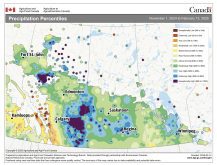Importers could decide to find safer suppliers, while sanctions may have long-term effects on how prices are structured
The war in Ukraine could shift global wheat trade patterns for years to come, says an economist.
Kenneth Scott Zuckerberg, lead grain economist with CoBank, said the war has been a big wake-up call to wheat-importing countries, especially those in the Middle East and North Africa (MENA) region.
Their food security has been threatened by the war because both Russia and Ukraine are major suppliers to that region.
“MENA nations will need to reduce their dependence on Russia and Ukraine to manage food insecurity, something that over the long-run should benefit developed grain markets in North and South America, Europe and Australia,” he wrote in a recent analysis.
Read Also

USDA’s August corn yield estimates are bearish
The yield estimates for wheat and soybeans were neutral to bullish, but these were largely a sideshow when compared with corn.
MarketsFarm analyst Bruce Burnett isn’t so sure that will be the case.
“For a lot of countries, it’s going to come down to price,” he said.
The price of Black Sea wheat is typically cheaper than wheat from other exporters due to its proximity to the MENA region.
However, he did acknowledge that the traditional price structure could change in the post-war environment.
Economic sanctions against Russia will likely remain in place for some time, which may limit the ability of MENA countries to complete transactions with Russia in U.S. dollars.
There may be extensive damage to Ukrainian ports and other grain-handling infrastructure that could result in extra costs being built into Ukrainian wheat prices.
It remains to be seen what wheat will be the low-cost option in the post-war era, said Burnett.
He acknowledged that there is merit to the CoBank assertion that at least some countries in the MENA region may want to diversify their list of suppliers, although he doesn’t anticipate a wholesale abandonment of Black Sea supplies.
One thing that is certain is that there are rising food security concerns in the region.
The United States Department of Agriculture’s Foreign Agricultural Service (FAS) said several factors have converged over the last 18 months to send global crop prices to near-record levels.
Russia’s invasion of Ukraine is the latest in a long list of factors including increased global demand, drought-reduced supplies, high energy prices pushing up fertilizer and transportation costs and countries imposing export bans.
“Over the last 18 months, wheat prices have risen nearly 110 percent, corn and vegetable oil prices are up 140 percent and soybean prices are up 90 percent,” stated the FAS in a recent report.
It said developing countries dependent on food imports are the most vulnerable to those price shocks, as evidenced by the food price crises of 2008 and 2012.
“Such countries tend to respond to price signals by shifting consumption and trade patterns,” said the FAS.
Ukraine accounts for 10 percent of global wheat trade. It typically exports milling wheat to the Middle East, Africa and Bangladesh and feed quality wheat to Asian countries.
The FAS said importers are shifting to wheat from the EU, India, Australia and Argentina. U.S. wheat is too expensive right now.
The short-term impact on consumers may be partially mitigated by food aid programs but high commodity prices, rising fuel costs and limited foreign exchange reserves could make maintaining subsidies difficult in some of those countries.
“Some markets may curtail imports and rely more on domestically produced grains, tubers or other staples,” said the FAS.
Zuckerberg expects the Ukraine situation to prop up wheat prices for at least two years. He is forecasting that only half of Ukraine’s 2021-22 wheat crop will be harvested in the summer of 2022.
“Even if a durable peace treaty is signed, there is growing risk that Ukraine’s 2022 planted acreage and yields will decline materially with damaged infrastructure, losses of agricultural equipment and machinery and/or a lack of affordable inputs,” he wrote in his analysis.
But the country’s problems may not stop there.
“Should the conflict last more than six months, next year’s winter wheat crop may not get fully planted during the September/October plantings window,” said Zuckerberg.
CoBank is forecasting that only three-quarters of the winter wheat crop will get planted in the fall of 2022.
It believes the country’s grain exports will remain choked for at least the next six months, although that situation could change with a ceasefire.
The upshot is that CoBank anticipates a precipitous decline in the global wheat stocks-to-use ratio in 2022-23 to 10.5 percent from 15 percent this year.
“While markets are somewhat calmer now vs. three weeks ago, CoBank sees tight stocks-to-use and price volatility continuing for at least two growing seasons,” said Zuckerberg.


















